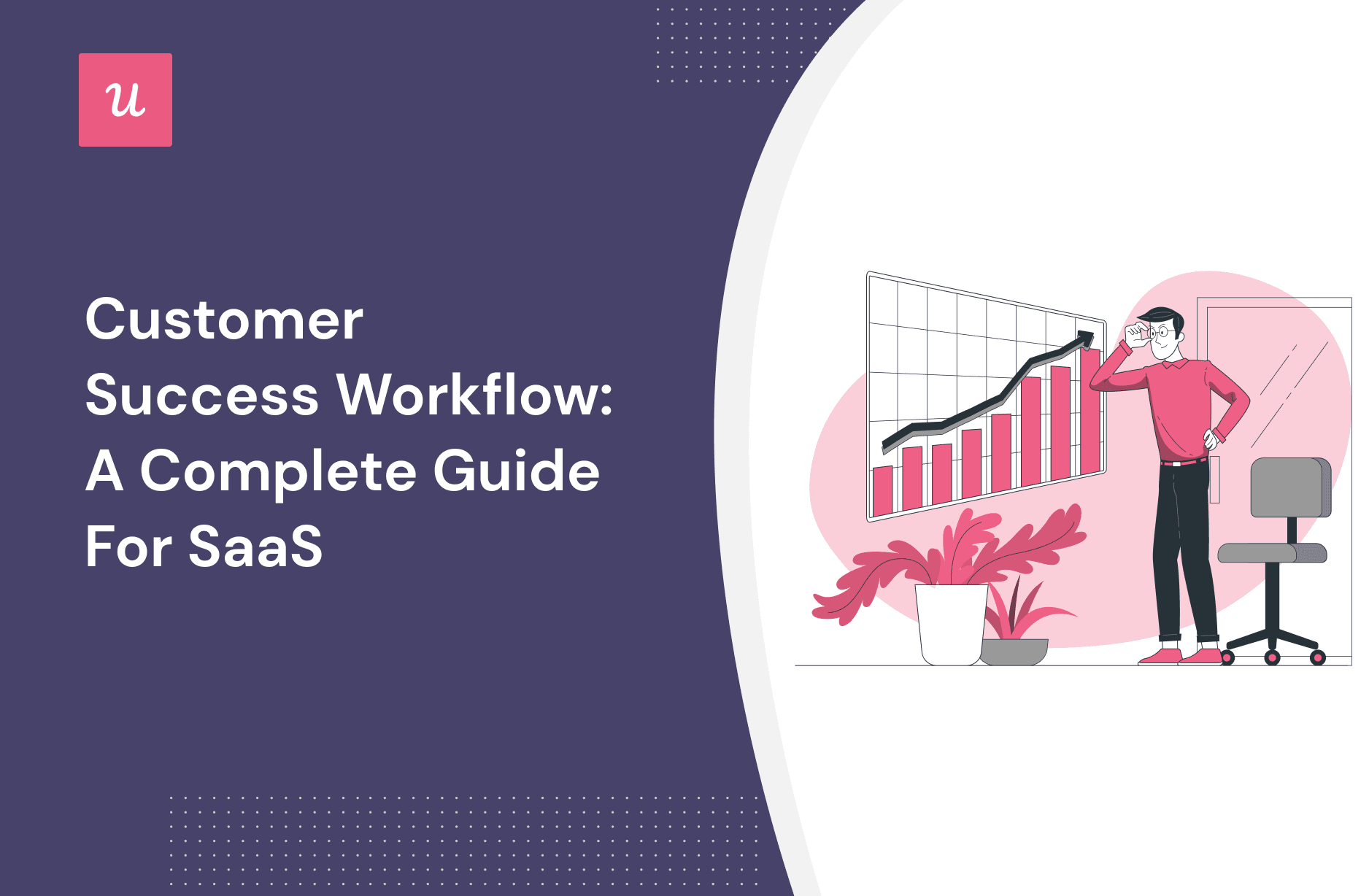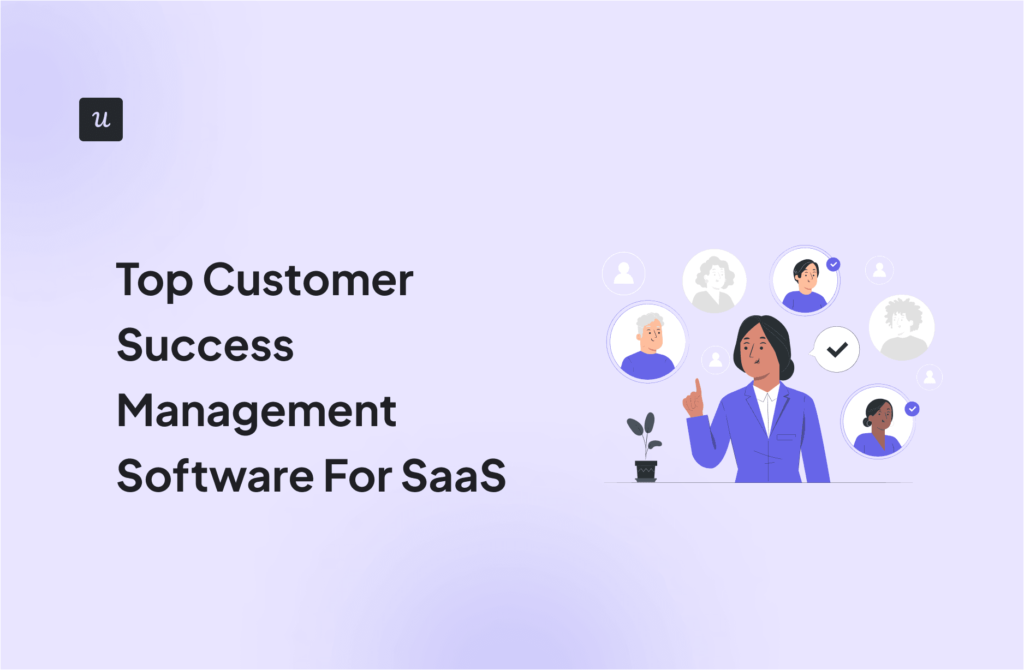
Without a clear customer success workflow, your output can easily become chaotic.
Since customer success is a relatively new career, CSMs tend to take on tasks from sales, support, and product marketing—which is often more than they can handle.
But, if your goal is to engage users and drive success, you better focus on following a solid workflow and only work on the most impactful tasks.
For this, we’ve made a guide on how to create a customer success workflow to streamline your success process.
Try Userpilot Now
See Why 1,000+ Teams Choose Userpilot

What is a customer success workflow?
A customer success workflow is a defined series of steps to ensure customers get their desired outcome using your product or service (including calls, emails, online meetings, product analytics, and more).
The goal is to provide customer success teams with a repeatable process to guide customers throughout the user journey, as well as identify and address user problems, churn risks, and upselling opportunities.
Why should you have a customer success workflow?
Without a customer success workflow, you’ll struggle to manage your workload, prioritize tasks, and communicate effectively—hindering your customer success goals.
But not only that, having a well-designed process can have multiple benefits, as it allows you to:
- Deliver value to your customers consistently.
- Boost customer satisfaction and build loyalty.
- Reduce churn and increase customer retention.
- Identify upsell and cross-sell opportunities.
- Improve productivity and efficiency.
- Align with other departments such as sales, marketing, and product.
- Track customer success metrics and their impact on your business.
So what do you need to know in order to set up your success process?
How to develop customer success workflows for SaaS?
Now, let’s go over our process for creating a customer success workflow in four steps:
Define customer success goals
The first step is to define the stages of your customer journey and set the goals you want to achieve at each stage. This way, you can align your customer success efforts with your customers’ needs and expectations.
However, your goals must be specific. For instance, at the onboarding stage, your main goal is to increase user activation. But what are the exact requirements for a user to be considered “activated”?
If—in your business—activation occurs when the user pays for a plan, then the real goal of your workflow is to improve trial-to-paid conversion by a percentage.
Identify touchpoints and map the customer journey
Once you’ve defined the goal of each stage, determine the milestones that users need to achieve throughout the journey—and map it out.
With a customer journey map, you can start documenting your workflow and expand the specific touchpoints that are required for each milestone.
For example, you can lay out the features that users need to adopt in order to reach activation when mapping the primary onboarding stage.

Put forward an SOP for your customer success team
Once you’ve built a customer journey map, develop a thorough SOP that can be used to help your customers achieve success.
For this, you can create a customer success playbook, which includes:
- Outcome: what success is from the customer’s perspective.
- Entry point: where the user must be in the journey to trigger the playbook.
- Exit point: where the user needs to get with the help of the playbook.
- Product adoption milestones: steps or subgoals your new customer must go through to get the desired outcome.
- Tasks: specific actions the user must take.
- Segment: user base segment that your playbook is designed for.
This way, you can document the exact actions you need to take in order to lead customers to success—and make it repeatable for your entire customer success team.
Analyze your customer success process and improve accordingly
Finally, apply your customer success workflow in the real world and analyze data to fine-tune it.
You can use product analytics to track feature usage, monitor user progress, and spot stages where users seem to face more friction. As well as define customer success KPIs to make sure you’re staying on the right path.
Best practices for creating a customer success workflow
Following our framework for developing a customer success workflow is a great start.
But additionally, there are four best practices that can potentially boost the effectiveness of your customer success process. They include:
Segment your customers to trigger personalized experiences
Not all users have the same goals and use cases.
That’s why your customer success workflow should address specific audience needs—for which you need to segment users.
By segmenting your customers based on their needs, behaviors, and goals, you can:
- Collect useful customer data.
- Personalize the product experience and exceed customer expectations.
- Learn what success looks like for your customers.
- Create a customer success plan that fits your user.
Take Kontentino’s onboarding screen as an example. They right away ask about your role, your company size, and if you’re working with a team:

Measure your customer success efforts
You can’t improve what you don’t measure.
Remember that to create an effective workflow, you need to track your customer success efforts across the user journey.
Measuring KPIs help you understand how your customers are performing, what challenges they are facing, and what opportunities they have for growth. As well as identify which customers are at risk of churning and which ones are ready for upselling.
The most useful customer success metrics include:
- Net promoter score. Which measures the overall sentiment that your user base has over your product.
- Churn rate. The rate at which customers are unsubscribing from your app.
- Customer stickiness score. The percentage of customers who renew and stick with your brand.
- Customer lifetime value (LTV). The average amount of money a business earns from a user over their lifetime as a paying customer.
- Customer acquisition cost. Which is the total cost of acquiring a new customer (it’s often paired with LTV).
- Customer engagement score. It measures the engagement of your customers based on their in-app activity.
Collect feedback regularly to identify improvement opportunities
Back-and-forth communication is the key to building customer relationships. It creates accountability and makes your customers feel invested in your brand.
That’s why you need to collect actionable feedback with surveys.
However, don’t receive feedback for the sake of it. You must identify improvement opportunities, implement them, and then communicate with your customers to show the impact of their response—closing the feedback loop in the process.
If not, both you and your users have wasted your time.
Some methods for collecting in-app feedback include CSAT surveys, CES surveys, feature request widgets, and NPS surveys (with follow-ups):

Automate customer success workflows with a customer success platform
Following your customer success workflow can be challenging and time-consuming if you rely on manual tasks. That’s why you need to automate, so you can save time, reduce errors, increase efficiency, and improve your results.
For this, adopting customer success tools is a great way to start, as it helps you:
- Centralize all your customer data, providing you with a single source of truth.
- Segment users and personalize in-app messages automatically.
- Monitor product analytics such as customer health, product usage, and manage customer lifecycle events.
- Trigger in-app surveys when it’s most relevant for the user.
- Managing renewals, upsells, and cross-sells.
With a leading customer success software like Userpilot, you can streamline your workflows and achieve your goals in the most time-efficient way possible.
How to improve your customer success workflow with Userpilot
For all the frameworks and best practices for creating a customer success workflow, you need tools to help you save time and money.
Thankfully—*shameless promotion warning*—Userpilot is honestly the most cost-efficient customer success software we know to apply customer success tactics without coding.
Here’s why:
Deliver personalized experiences with advanced segmentation
With Userpilot, you can segment users based on a wide range of attributes such as ID, roles, feature usage, JTBDs, NPS response, and more.
With the advanced segmentation feature, you can trigger UI patterns such as tooltips, slideouts, and modals based on the following:
- Customer’s use case and goals
- In-app behavior and engagement
- User’s journey stage
- Specific events and the count of them using custom attributes
This way, you can personalize the product experience and engage customers throughout their journey.

Act on customer data with insightful product analytics
Userpilot gives you access to advanced product analytics to monitor in-app behavior and product usage. Including plenty of functionalities, such as the ability to tag features, track their usage, set goals, and see how your users progress across their lifecycle.
Our analytics tool allows you to, for example, see how different user groups engage with your product and segment them based on the features they engage with.
Collect customer feedback with in-app surveys
Additionally, Userpilot lets you collect feedback and understand user sentiment with contextual in-app surveys and mobile surveys such as NPS, CSAT, and CES. And trigger them based on segment, user ID, event tracking, and more.
For example, you can also launch NPS surveys and tag responses to identify which keywords are linked to promoters or detractors. As well as customize your surveys to match your brand aesthetics:

Conclusion
In SaaS, retaining customers is as impactful (if not more impactful) than acquiring them.
That means, focusing on building a great customer success workflow that keeps your customers happy is essential for healthy growth and success.
So now that you know the framework to build an effective workflow, why not get a Userpilot demo to automate your customer success operations without coding?






